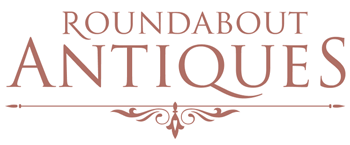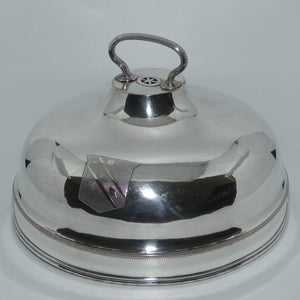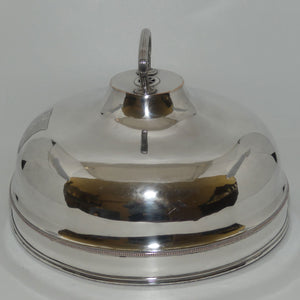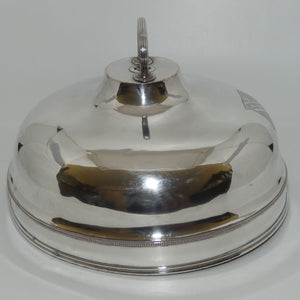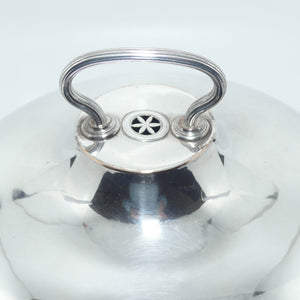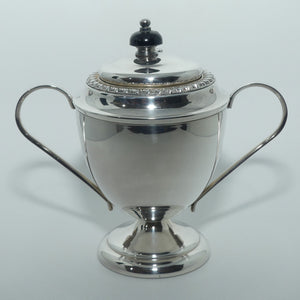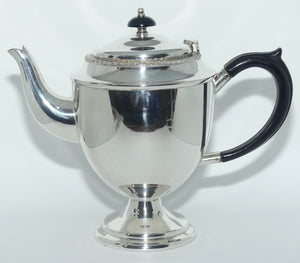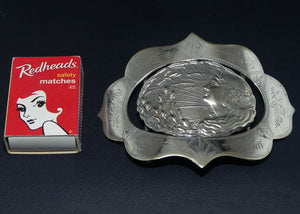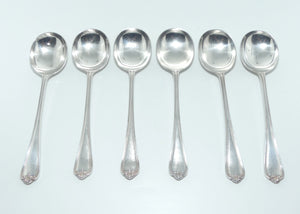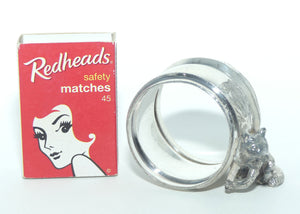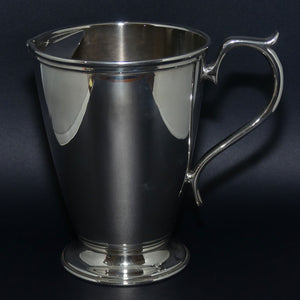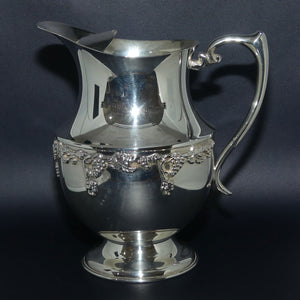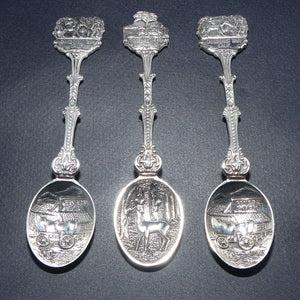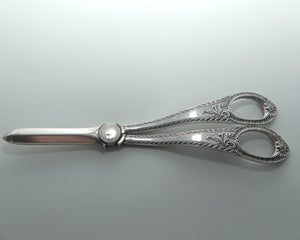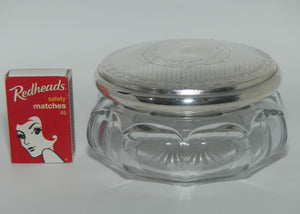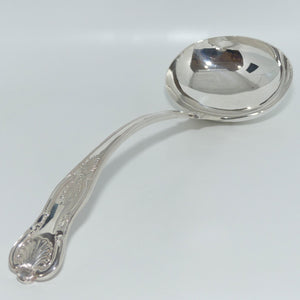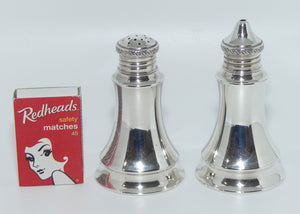{"id":8096346931428,"title":"Georgian era Old Sheffield Plate dish cover | Bright Cut Shield | #1","handle":"georgian-era-old-sheffield-plate-dish-cover-bright-cut-shield","description":"Georgian era Old Sheffield Plate dish cover\u003cbr\u003eHas a beautiful \u003cspan data-mce-fragment=\"1\"\u003eBright Cut Shield crest, the diagonal stripe having 3 leaves and an oustretched hand, similar to a STOP signal\u003cbr\u003e\u003c\/span\u003e\u003cspan data-mce-fragment=\"1\"\u003e\u003cbr\u003eUnmarked - as most Sheffield plate is - but the quality can never be mistaken!\u003cbr\u003ec.1830\u003cbr\u003e\u003cbr\u003eApprox 25.5cms (10\") diameter\u003cbr\u003eApprox 17cms (6 3\/4\") tall\u003cbr\u003e\u003cbr\u003eIn original condition\u003cbr\u003eOn the high points and near handle is some loss of the plating exposing the copper but overall given the age of the piece, quite superb - cover is slightly out of round, but again, given the age, quite superb\u003cbr\u003e\u003cbr\u003e\u003cbr data-mce-fragment=\"1\"\u003e\u003cstrong data-mce-fragment=\"1\"\u003eWhat is Sheffield Plate?\u003c\/strong\u003e\u003cbr data-mce-fragment=\"1\"\u003eSheffield plate, in metalwork, is generally an item made of copper coated with silver by fusion. The technique was discovered about 1742 by Thomas Boulsover, a Sheffield cutler, who noted that the combination of fused silver and copper retained all the ductility possessed by both metals and acted as one in response to manipulation.\u003cbr data-mce-fragment=\"1\"\u003e\u003cbr data-mce-fragment=\"1\"\u003eSheffield plate was produced as follows. An ingot of copper, slightly alloyed with zinc and lead, was covered on both top and bottom with a sheet of silver and fired. When the silver began to melt, the ingot was removed from the furnace, cooled, and rolled. The edges of pieces made were rolled over to hide the copper that was visible when the sheet was cut. At first Boulsover produced only buttons, but his former apprentice, Joseph Hancock, later applied the process to other articles.\u003cbr data-mce-fragment=\"1\"\u003e\u003cbr data-mce-fragment=\"1\"\u003eThe production of fused plate was not restricted to Sheffield alone. In 1762 Matthew Boulton began producing Sheffield plate at Soho, Birmingham, and various workshops in London, Nottingham, and Dublin. Factories in several European countries and North America also made pieces by Boulsover’s method. After 1830 “German silver,” nickel alloyed with copper and zinc, often replaced copper as the base metal. With the introduction of plating by electrolysis in the 1840s, the production of Sheffield plate declined and by the 1870s had all but ceased.\u003cbr\u003e\u003c\/span\u003e","published_at":"2023-12-09T06:00:08+10:00","created_at":"2023-12-04T11:21:52+10:00","vendor":"Sheffield Plate","type":"Dish Cover","tags":["Antique","plated"],"price":30000,"price_min":30000,"price_max":30000,"available":true,"price_varies":false,"compare_at_price":null,"compare_at_price_min":0,"compare_at_price_max":0,"compare_at_price_varies":false,"variants":[{"id":44369155653860,"title":"Default Title","option1":"Default Title","option2":null,"option3":null,"sku":"232402040C","requires_shipping":true,"taxable":true,"featured_image":null,"available":true,"name":"Georgian era Old Sheffield Plate dish cover | Bright Cut Shield | #1","public_title":null,"options":["Default Title"],"price":30000,"weight":2000,"compare_at_price":null,"inventory_management":"shopify","barcode":null,"requires_selling_plan":false,"selling_plan_allocations":[]}],"images":["\/\/www.roundaboutantiques.com.au\/cdn\/shop\/files\/plate_cover_1a.jpg?v=1701653104","\/\/www.roundaboutantiques.com.au\/cdn\/shop\/files\/plate_cover_1b.jpg?v=1701653104","\/\/www.roundaboutantiques.com.au\/cdn\/shop\/files\/plate_cover_1c.jpg?v=1701653104","\/\/www.roundaboutantiques.com.au\/cdn\/shop\/files\/plate_cover_1d.jpg?v=1701653104","\/\/www.roundaboutantiques.com.au\/cdn\/shop\/files\/plate_cover_1e.jpg?v=1701653103","\/\/www.roundaboutantiques.com.au\/cdn\/shop\/files\/plate_cover_1f.jpg?v=1701653103","\/\/www.roundaboutantiques.com.au\/cdn\/shop\/files\/plate_cover_1g.jpg?v=1701653103","\/\/www.roundaboutantiques.com.au\/cdn\/shop\/files\/plate_cover_1h.jpg?v=1701653105"],"featured_image":"\/\/www.roundaboutantiques.com.au\/cdn\/shop\/files\/plate_cover_1a.jpg?v=1701653104","options":["Title"],"media":[{"alt":"Georgian era Old Sheffield Plate dish cover | Bright Cut Shield ","id":55352807981284,"position":1,"preview_image":{"aspect_ratio":1.0,"height":1250,"width":1250,"src":"\/\/www.roundaboutantiques.com.au\/cdn\/shop\/files\/plate_cover_1a.jpg?v=1701653104"},"aspect_ratio":1.0,"height":1250,"media_type":"image","src":"\/\/www.roundaboutantiques.com.au\/cdn\/shop\/files\/plate_cover_1a.jpg?v=1701653104","width":1250},{"alt":"Georgian era Old Sheffield Plate dish cover | Bright Cut Shield ","id":55352808014052,"position":2,"preview_image":{"aspect_ratio":1.0,"height":1250,"width":1250,"src":"\/\/www.roundaboutantiques.com.au\/cdn\/shop\/files\/plate_cover_1b.jpg?v=1701653104"},"aspect_ratio":1.0,"height":1250,"media_type":"image","src":"\/\/www.roundaboutantiques.com.au\/cdn\/shop\/files\/plate_cover_1b.jpg?v=1701653104","width":1250},{"alt":"Georgian era Old Sheffield Plate dish cover | Bright Cut Shield ","id":55352808046820,"position":3,"preview_image":{"aspect_ratio":1.0,"height":1250,"width":1250,"src":"\/\/www.roundaboutantiques.com.au\/cdn\/shop\/files\/plate_cover_1c.jpg?v=1701653104"},"aspect_ratio":1.0,"height":1250,"media_type":"image","src":"\/\/www.roundaboutantiques.com.au\/cdn\/shop\/files\/plate_cover_1c.jpg?v=1701653104","width":1250},{"alt":"Georgian era Old Sheffield Plate dish cover | Bright Cut Shield ","id":55352808079588,"position":4,"preview_image":{"aspect_ratio":1.0,"height":1250,"width":1250,"src":"\/\/www.roundaboutantiques.com.au\/cdn\/shop\/files\/plate_cover_1d.jpg?v=1701653104"},"aspect_ratio":1.0,"height":1250,"media_type":"image","src":"\/\/www.roundaboutantiques.com.au\/cdn\/shop\/files\/plate_cover_1d.jpg?v=1701653104","width":1250},{"alt":"Georgian era Old Sheffield Plate dish cover | Bright Cut Shield ","id":55352808112356,"position":5,"preview_image":{"aspect_ratio":1.0,"height":1250,"width":1250,"src":"\/\/www.roundaboutantiques.com.au\/cdn\/shop\/files\/plate_cover_1e.jpg?v=1701653103"},"aspect_ratio":1.0,"height":1250,"media_type":"image","src":"\/\/www.roundaboutantiques.com.au\/cdn\/shop\/files\/plate_cover_1e.jpg?v=1701653103","width":1250},{"alt":"Georgian era Old Sheffield Plate dish cover | Bright Cut Shield ","id":55352808145124,"position":6,"preview_image":{"aspect_ratio":1.0,"height":1250,"width":1250,"src":"\/\/www.roundaboutantiques.com.au\/cdn\/shop\/files\/plate_cover_1f.jpg?v=1701653103"},"aspect_ratio":1.0,"height":1250,"media_type":"image","src":"\/\/www.roundaboutantiques.com.au\/cdn\/shop\/files\/plate_cover_1f.jpg?v=1701653103","width":1250},{"alt":"Georgian era Old Sheffield Plate dish cover | Bright Cut Shield ","id":55352808177892,"position":7,"preview_image":{"aspect_ratio":1.0,"height":1250,"width":1250,"src":"\/\/www.roundaboutantiques.com.au\/cdn\/shop\/files\/plate_cover_1g.jpg?v=1701653103"},"aspect_ratio":1.0,"height":1250,"media_type":"image","src":"\/\/www.roundaboutantiques.com.au\/cdn\/shop\/files\/plate_cover_1g.jpg?v=1701653103","width":1250},{"alt":"Georgian era Old Sheffield Plate dish cover | Bright Cut Shield ","id":55352808210660,"position":8,"preview_image":{"aspect_ratio":1.0,"height":1250,"width":1250,"src":"\/\/www.roundaboutantiques.com.au\/cdn\/shop\/files\/plate_cover_1h.jpg?v=1701653105"},"aspect_ratio":1.0,"height":1250,"media_type":"image","src":"\/\/www.roundaboutantiques.com.au\/cdn\/shop\/files\/plate_cover_1h.jpg?v=1701653105","width":1250}],"requires_selling_plan":false,"selling_plan_groups":[],"content":"Georgian era Old Sheffield Plate dish cover\u003cbr\u003eHas a beautiful \u003cspan data-mce-fragment=\"1\"\u003eBright Cut Shield crest, the diagonal stripe having 3 leaves and an oustretched hand, similar to a STOP signal\u003cbr\u003e\u003c\/span\u003e\u003cspan data-mce-fragment=\"1\"\u003e\u003cbr\u003eUnmarked - as most Sheffield plate is - but the quality can never be mistaken!\u003cbr\u003ec.1830\u003cbr\u003e\u003cbr\u003eApprox 25.5cms (10\") diameter\u003cbr\u003eApprox 17cms (6 3\/4\") tall\u003cbr\u003e\u003cbr\u003eIn original condition\u003cbr\u003eOn the high points and near handle is some loss of the plating exposing the copper but overall given the age of the piece, quite superb - cover is slightly out of round, but again, given the age, quite superb\u003cbr\u003e\u003cbr\u003e\u003cbr data-mce-fragment=\"1\"\u003e\u003cstrong data-mce-fragment=\"1\"\u003eWhat is Sheffield Plate?\u003c\/strong\u003e\u003cbr data-mce-fragment=\"1\"\u003eSheffield plate, in metalwork, is generally an item made of copper coated with silver by fusion. The technique was discovered about 1742 by Thomas Boulsover, a Sheffield cutler, who noted that the combination of fused silver and copper retained all the ductility possessed by both metals and acted as one in response to manipulation.\u003cbr data-mce-fragment=\"1\"\u003e\u003cbr data-mce-fragment=\"1\"\u003eSheffield plate was produced as follows. An ingot of copper, slightly alloyed with zinc and lead, was covered on both top and bottom with a sheet of silver and fired. When the silver began to melt, the ingot was removed from the furnace, cooled, and rolled. The edges of pieces made were rolled over to hide the copper that was visible when the sheet was cut. At first Boulsover produced only buttons, but his former apprentice, Joseph Hancock, later applied the process to other articles.\u003cbr data-mce-fragment=\"1\"\u003e\u003cbr data-mce-fragment=\"1\"\u003eThe production of fused plate was not restricted to Sheffield alone. In 1762 Matthew Boulton began producing Sheffield plate at Soho, Birmingham, and various workshops in London, Nottingham, and Dublin. Factories in several European countries and North America also made pieces by Boulsover’s method. After 1830 “German silver,” nickel alloyed with copper and zinc, often replaced copper as the base metal. With the introduction of plating by electrolysis in the 1840s, the production of Sheffield plate declined and by the 1870s had all but ceased.\u003cbr\u003e\u003c\/span\u003e"}
